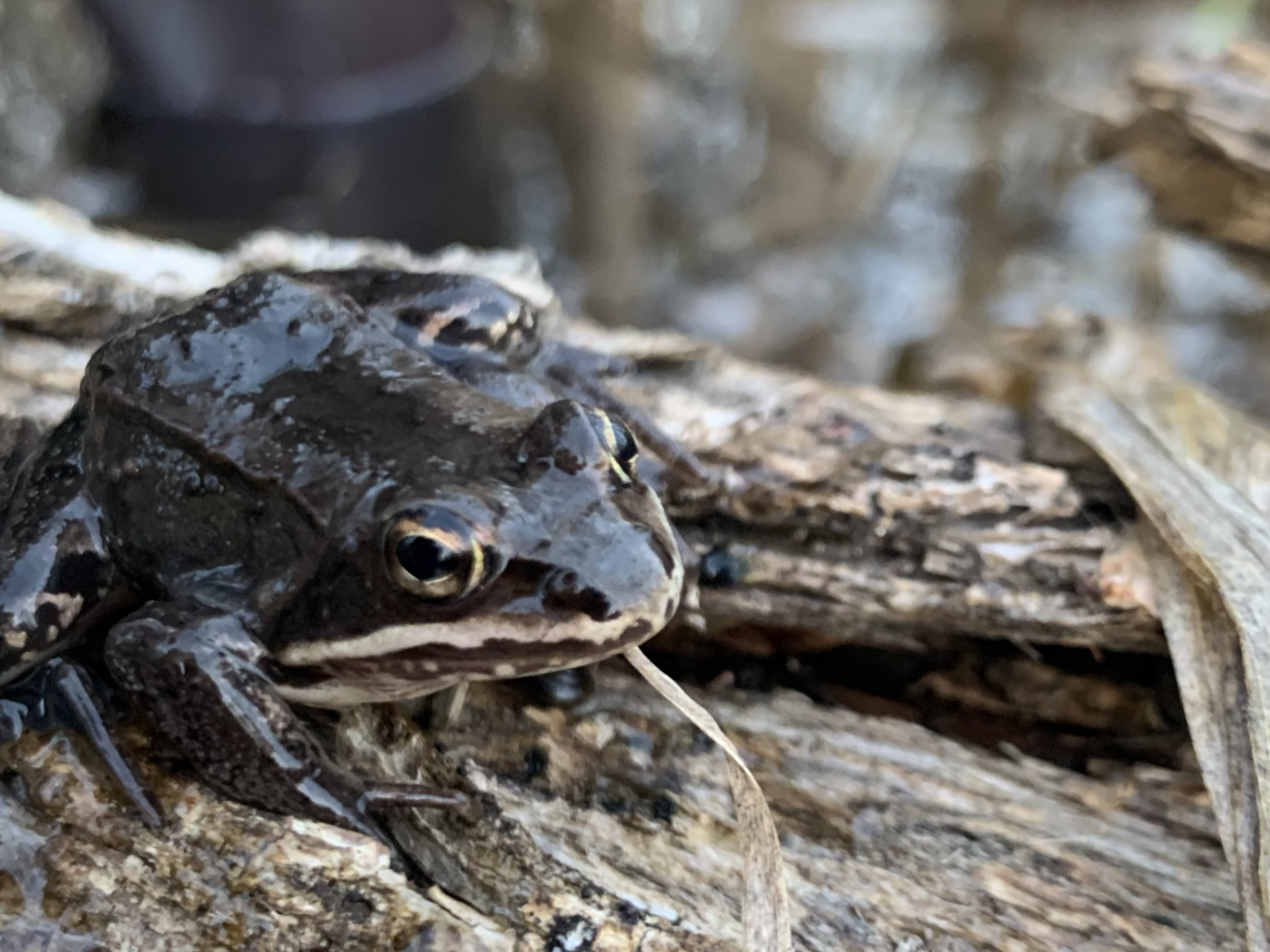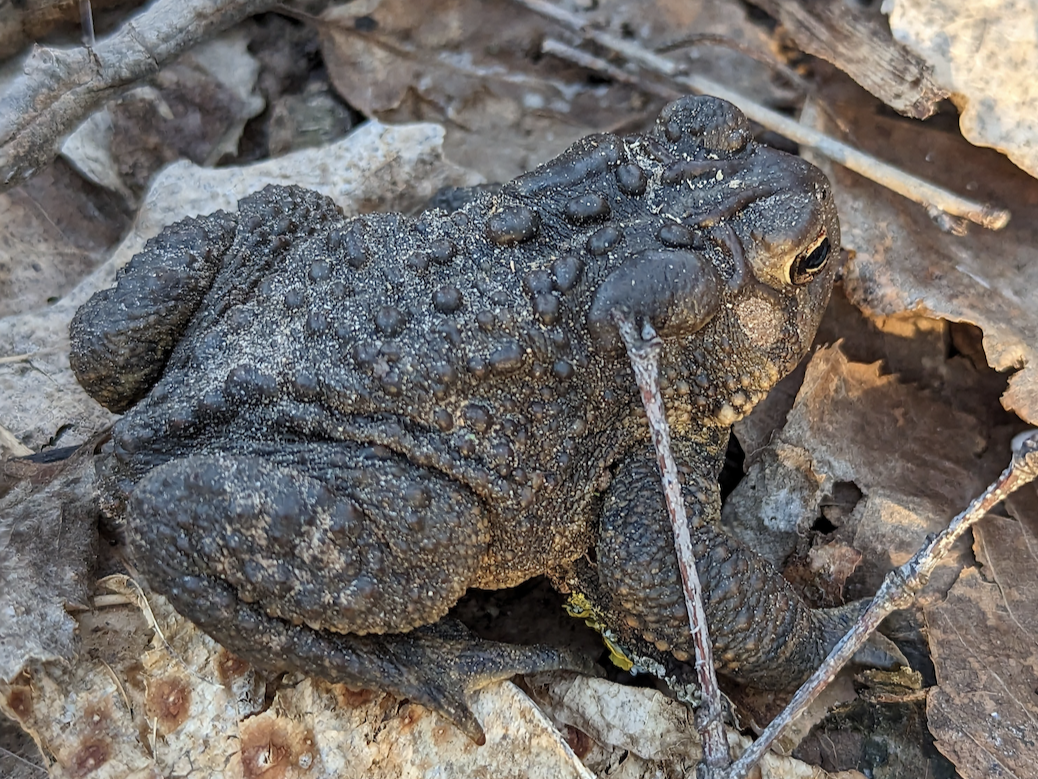Josh's Frogs
Glacial Lakes Conservancy: Acoustic Monitoring on Willow Creek Preserve

A wood frog on Willow Creek Preserve. Photo credit: Isabel Mueller
Glacial Lakes Conservancy, Inc. won a Josh's Frogs 2023 Amphibian Conservation Grant for their project, Monitoring of Habitat Restoration Success Through Monitoring of Amphibian Response on Willow Creek Preserve. We interviewed the Conservancy's Land Project Coordinator and Willow Creek Project Manager, Isabel Mueller, to learn more about this project.
How do you plan to use the grant money?
The funds from this grant will be used to continue our biodiversity research project on our WillowCreek Preserve. More specifically, one portion of this overall project, which is our bioacoustic monitoring of amphibians and other species. While we would love to be on the site everyday listening and looking for all the species that call our Preserve home, that is darn near impossible! The acoustic data collection allows us to evaluate data from large periods of time and analyze it for calls of many different species. We have had two years of this style of data collection on site and it has helped us so far to establish a better understanding of where different critters favor on our 143 acre Preserve as well as what new species are chirping in every year. This helps to tell us a lot about what restoration is needed, how our restoration is working, and where we could use more!
What does winning this grant allow you to do that you might not have otherwise?
Despite the massive need for baseline understanding of sites that will be restored to benefit fish and wildlife species, many funders that require you to have outcomes that benefit these critters, don’t provide funding to research them. Without knowing what we have on the site already, we won’t truly know how well we have benefitted these species. This is where funding opportunities like this come in handy! While they are few and far in between, they are so appreciated as they allow us to fund research projects that need to occur in order for proper habitat restoration to be done. Funders like you allow for small organizations like Glacial Lakes Conservancy to make very secure and sound decisions on our next steps with land restoration.
When do you expect to see results from this? What do you hope they'll look like?
As mentioned, this study has been going on for two years now. Every year our ecologist who helps on the project provides reports by the end of the year. So we anticipate seeing the results from this funding at the end of 2024. The hope is that with the water quality efforts being carried out and wetland restoration that will be occurring prior to then, that we are creating a better habitat for the Species of Local Conservation Interest that we want to see and protect on our land! Which in turn means, we are hoping to hear a lot more activity especially in our wetland areas!

An american toad on Willow Creek Preserve. Photo credit: Isabel Mueller
How will this impact amphibian conservation specific to this instance?
With all of the data collected, we are able to determine what restoration needs to happen and where on our Preserve in order to better serve local wildlife communities. We in particular love our amphibian friends, and despite having decent populations of some species, others that are common don’t call from here. The hope is that with more and smarter restoration efforts, we will be able to provide a safe habitat for amphibians and other species alike.
What are the larger implications of your work?
As mentioned earlier, this project is a subsection of our larger biodiversity project on this Preserve. Willow Creek is a large preserve with a creek that leads to the Sheboygan River Area of Concern. It is also one of the last natural areas around its location, with development all around the Preserve, this space is one of the last diverse ecosystems around for many species. This biodiversity data collection up till this point has acted as our baseline, to get a better understanding of which species use what spaces on the land. This helps us to make more informed management decisions; from wetland enhancement projects to invasive removal to the creation of green stormwater infrastructure. All of these plans for the coming year were formulated with this data, because it showed us a need for improvements with habitat focus in mind. This practice is currently only happening on our Willow Creek Preserve, but down the line, we hope to mimic it on our other sites as well.
What message or information would you like to share with the reptile and amphibian pet community?
Willow Creek Preserve currently serves as a home to many known species such as the blue spotted salamander, leopard frog, chorus frog, blanding's turtles, snapping turtles, and so many more critters! We have a mission of permanently preserving and protecting land and water resources for future generations, not only our grandchildren and beyond, but so too the species that use the site. We care for the animals and land because they care for us and we are so eager to share with our community how important this site, this research, this data, and this land management is!
How would someone make a donation to your organization?
Glacial Lakes Conservancy is a non-profit land trust based in Sheboygan, Wisconsin. We serve a five county area and are greatly dependent on donations, memberships, grants, and community partnerships. Donations can be made online at https://www.glaciallakes.org/donate.html. You could also become a member or volunteer at any point to stay connected with us and the land!
Where could someone learn more about your project?
We share a lot about this site via our emails, website (https://www.glaciallakes.org/), and social media. We will be undergoing some website improvements soon in hopes to better display more information about what we do at Willow Creek Preserve, but for now, social media is typically our best friend!
Anything else you feel we should know or discuss?
We are endlessly grateful for groups like yours funding these projects! Keep up the good work and thank you so much!
